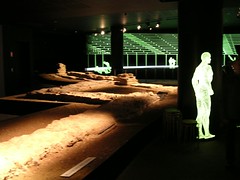[Details of the sources used in the book can be found here]
The Aftermath
Some of the text I wrote for Gladiators: Fighting to the Death in Ancient Rome did not make it into the final version of the book. Publishing is (and always has been) a balance between words, pictures, space, and cost; every writer is used to putting to one side material that is expendable in a given context but which might one day find a use somewhere. What follows, then, is a perspective on the aftermath of gladiatorial combat: a brief history of research, impact, and recreation, if you like. Read it is a taster of the other material you will find in the book, or read it after the book to answer those bothersome ‘what happened next?’ questions. Either way, buy the book!
Rediscovery
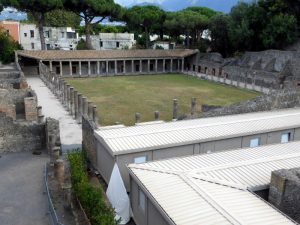
Gladiator barracks at Pompeii. Image: MCB
The remnants of the world of the gladiators began to be understood during the Renaissance, with its most obvious legacy being the arenas around the Roman world. Taken together with the mosaics, graffiti, statuettes, and artefacts depicting gladiators, the surviving classical texts made it clear what had been happening. Examination of the texts yielded information on the types of gladiator and how they operated, as well as confirming aspects of the terminology. By way of example, the term galerus for the shoulderguard of a retiarius derives from a gloss by a scholiast on the manuscript of Juvenal’s eighth satire (and where he got the term from remains a mystery)! However, not until the the discovery of gladiatorial arms and armour during the excavation of the quadriporticus at Pompeii in the 19th century was it revealed just how elaborately decorated some of the armour could be – so much so, that it was long argued that this was ‘parade’ equipment, a similar argument to that deployed to explain the decorated equipment of soldiers. In neither case was this true: decorated gladiatorial armour, just like its military counterpart, was designed for use and was fully functional. Other gladiatorial equipment has been found, but never in the quantity discovered in the gladiatorial barracks at Pompeii.
These items were found at a time when archaeology was in its infancy, caught in the transformation from the polite curiosity of antiquarianism to a more rigorous discipline. In the age of scientific archaeology, there are a number of recent discoveries that have added to our understanding of gladiators. The excavation of the gladiator cemetery at Ephesus provided the sort of skeletal data that modern archaeologists crave, providing information on diet, health, wounds, the practice of medicine, and even weaponry. Similarly, more than 80 headless skeletons from York (UK) have been identified as possible gladiators or condemned men (noxii), DNA analysis showing most to have been indigenous Britons but with at least one man from the Middle East or North Africa.
Just as modern archaeology has revealed the remains of the gladiators themselves, it has allowed the detection of new structures associated with the games, both by remote sensing and by excavation. The gladiator training school at Carnuntum in Austria has already been mentioned, and here sophisticated three-dimensional geophysics has enabled a detailed understanding of the structure to be formed before there has even been any excavation. Rescue excavation in advance of development beneath the Guildhall in the heart of the City of London produced astonishingly well-preserved remains of the first timber amphitheatre of the Roman town. Measuring 100m by 85m, two distinct phases were identified, showing that it was founded in the AD 70s and then refitted in the early 2nd century, possibly around the time the Emperor Hadrian visited Britain (in AD 122). It went out of use in the 4th century and may have become the municipal dump, but it was to still to play an important part in linking the gladiatorial past to the present day. Because of its location and shape (its oval layout influencing the later road network), it may have become a place of assembly for the Anglo-Saxon population of Lundenwic in the 11th century, with a church over the southern half and a large timber hall over the northern part (ultimately developing into the medieval Guildhall which survives today and where, as we shall see, its past is sometimes brought back to life).
Even older, well-known structures like the Colosseum can yield new information when the latest techniques are applied. Peter Connolly’s succinct analysis of that ultimate arena revealed much that had been ignored or misunderstood, simply because he was able to turn an informed eye to it. More recent analysis has been undertaken in advance of cleaning the amphitheatre and this has produced more new data. As part of an 80-million-euro restoration and cleaning programme, archaeologists revealed new polychrome frescoes and graffiti (including a palm frond and crown, as well as phallic symbols) within an internal passageway of the Colosseum.
Modern perceptions
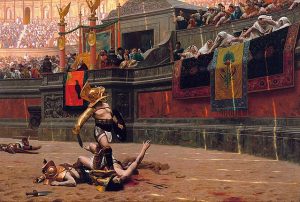
Gerôme’s Pollice Verso
The important role of Jean-Léon Gérôme’s 1872 painting Pollice Verso in the modern perception of gladiatorial combat was mentioned at the beginning of this book. It was in turn directly inspired by seeing the surviving gladiatorial armour from Pompeii in the museum at Naples. The central pair of figures was subsequently turned into a sculpture, whilst Gérôme was himself commemorated by his son-in-law, who added him into the original sculptural group as if in the act of sculpting it, and that can now be seen in the Musée d’Orsay in Paris. A far less well-known painting is The Spoliarium from 1886 by Juan Luna, who came from the Philippines. As the title suggests, its subject is far less noble than Gérôme’s, depicting a dead gladiator being stripped after a fight in the room dedicated for that purpose. As such, it was intended as an allegory for more recent colonial exploitation. Both pictures represent 19th-century artists coming to terms with the gladiatorial phenomenon and how it relates to contemporary society, a lead which was subsequently followed by the moving picture industry.
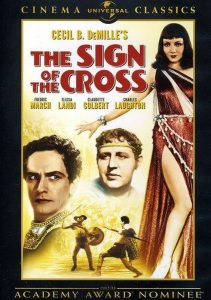
The Sign of The Cross poster
Film is undoubtedly one of the principal ways in which a modern audience has become aware of gladiators and their world. Surprisingly, though, gladiatorial combat did not really feature in the early Hollywood spectaculars. Gladiators did appear in Cecil B. DeMille’s The Sign of the Cross in 1932, a film which established the tradition of assuming all gladiators swore the famous ‘ave, imperator, morituri te salutant’ oath. In true DeMille style, a set-piece with 60 pairs of gladiators fighting at the same time was shown. Stanley Kubrick’s 1960 film of Spartacus, despite the gladiatorial section only occupying a small portion of the film, set the standard for the cinematic portrayal of gladiators. In 1954, Demetrius and the Gladiators, a biblical epic that incidentally depicted gladiatorial training and combat, including practising at the stake, but inaccurately leads a pompa into the arena which culminates with the obligatory ‘Hail, Caesar!’ Once again, multiple pairs of gladiators fight at once. However, after a 40-year hiatus, the most significant film is without doubt Ridley Scott’s Gladiator of 2000. With much in common with Anthony Mann’s 1964 epic The Fall of the Roman Empire, it inevitably referenced Commodus’ penchant for gladiatorial combat and even imitated one scene from the latter film where the hero fights to the death with the emperor within a (rectangular) arena of shields held by the Praetorian Guard. Even so, despite employing one of the leading academics on the subject, Gladiator got virtually every detail of combat in the arena wrong, preferring to draw upon cinematic tradition than evidence. The adviser’s account of her experience makes for interesting reading.
Related to this (and often directly informing it) has been the place of literature in placing gladiatorial combat before the public nowadays. Edward Bulwer-Lytton’s 1834 novel The Last Days of Pompeii was inspired by a painting of the same name and included a pivotal scene in the arena that coincides with the eruption of Vesuvius. Before Spartacus the movie there was Spartacus the novel, and not just the one by Howard Fast (whose left-wing, post-McCarthyism political message was subtly altered and given a religious spin by the 1960 film). Published in 1951, Fast’s Spartacus came some 18 years after that of the Scottish novelist James Leslie Mitchell, better known as Lewis Grassic Gibbon, and only 12 years after The Gladiators by Arthur Koestler, which also dealt with – yes, you guessed it – Spartacus. Indeed, even Mitchell/Gibbon was a latecomer to the theme if we take into account the play Robert Montgomery Bird wrote for the actor Edwin Forrest in 1831. Called The Gladiator, it was – perhaps inevitably – about Spartacus and had a strong anti-slavery theme to it. When it was performed in London, it was also apparently thought by some to have an anti-British tone too.

The Far Arena
An unusual twist to gladiatorial fiction, combining it with science fiction, brought Richard Ben Sapir’s 1979 novel The Far Arena, which tells the story of a gladiator frozen in Arctic ice, who is brought back to life in the modern world, making much play on how he reacts to it and it to him. Spartacus, however, remains popular and his struggle was taken up again in two historical novels by Ben Kane, Spartacus: the Gladiator and Spartacus: Rebellion. Simon Scarrow, on the other hand, has taken gladiatorial fiction to a younger audience with his series of books for older children and early teens. Meanwhile, Russell Whitfield explored the theme of female gladiators in his 2008 novel Gladiatrix. These are just a few of the many fictional accounts of life in the arena. Just as the Gladiator movie inspired an outburst of interest in Roman culture in general, so it acted as a spur to the production of historical novels on gladiatorial themes.
Where Hollywood has often been strangely reluctant, however, television has stepped in. Here the television series Spartacus (2010–13), undoubtedly helped by the success of Ridley Scott’s Gladiator, brought Roman gladiatorial combat to a broad audience. With the sort of amounts of blood, sex, intrigue, and action that Juvenal would have enjoyed disapproving of, it captured a loyal fan base. In terms of the accuracy of its portrayal of gladiatorial equipment and training, it unsurprisingly followed Hollywood traditions in leaving much to be desired. As an intriguing aside, one particular episode of Star Trek (season 2 episode 25, ‘Bread and Circuses’) is worthy of mention. In this, the crew of the Enterprise encounter a world where the Roman Empire has continued into the modern (or 1960s) age and gladiatorial contests are televised. As an ‘alternative universe’ interpretation, it worked quite well and gave a sense of how gladiators might still find a place in a modern industrial society. As with all science fiction, it could not help but reflect and comment upon contemporary society.

Gloster Gladiator of the Hal Far fighter group
There were other famous gladiators. On July 1st 1935, the Gloster Aircraft Company Ltd named their new biplane fighter with an enclosed cockpit the Gladiator. At the time, it was just a fighter aircraft designed to meet the latest Air Ministry specification F.7/30 and given a name beginning with G like all of the company’s other products. However, it was to live up to its name when, in 1940, Gladiators of the Hal Far Fighter Flight defended Malta during the siege of that island by the Italian Regia Aeronautica. The names of three of these machines – Faith, Hope, and Charity – have become legendary for their role in this modern gladiatorial combat.
After that, any modern usage of the term gladiator has to seem mundane. It regularly occurs in a sporting context as an (invariably overworked) simile or metaphor, particularly in contact sports such as wrestling or boxing, but the UK television series Gladiators (1992–2000, based on American Gladiators) brought a modern interpretation of paired combat that was acceptable to a modern audience and harked back to the ‘Bread and Circuses’ episode of Star Trek. Here a group of ‘gladiators’ with exotic stage names like Lightning, Trojan, and Wolf fought against members of the public. In a modern world conscious of health and safety considerations, the resemblance to original gladiators was only ever going to be extremely superficial, but it did serve to point up the fact that gladiatorial combat still has a place in the modern consciousness. We are aware of gladiators, and some have even sought to recreate their battles more accurately that Hollywood, fiction, or television can manage.
Re-enactment and experiment
It is all very well pontificating about gladiators, but the study of the Roman army has shown the absolute value of experimental archaeology and re-enactment when examining the ancient world. Not only for providing a public face for the all-too-often dry academic study of the subject, but also to attempt to learn something about the material culture and everyday considerations of gladiatorial life. Naturally, anything learned from such ventures has to be hedged around with provisos. That said, no sword can truly be understood until an accurate replica of it has hacked at a cabbage.
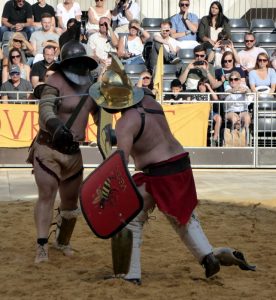
Gladiators of Britannia, August 2017
In the Guildhall Yard in London, on the site of the Roman amphitheatre (the outline of which is marked in the pavement of the yard), gladiators returned to amuse the masses in 2001. Of course, this was not real gladiatorial combat. Like all re-enactment or ‘living history’, it was entertainment that sought to educate in an informed and informative way, in this case to mark the 25th anniversary of the foundation of the Museum of London. Whilst the wounds and violent deaths were not real, the entertainment had much in common with the showmanship (and possibly, in a few instances, even choreographed nature) of the original shows.
Just as the number of re-enactment groups depicting the Roman army has increased since the 1970s, so gladiatorial groups have appeared. With Britannia in the UK and Ars Dimicandi in Italy, as well as Familia Gladiatoria in Austria, there are now a number of groups recreating the world of the gladiators for the modern age. This is in part (some might say largely) due to the work of Dr Marcus Junkelmann, whose 2000 book Das Spiel mit dem Tod (literally ‘Playing with Death’) tackled gladiatorial combat from the standpoint of experimental archaeology and re-enactment. As such, his reconstructions of what gladiators actually looked like are extremely influential on modern re-enactors, despite the fact his book has only appeared in German. Part of the reason for this was his contribution to the exhibition Gladiators and Caesars – the accompanying publication included a article by Junkelmann.
As with all experimental archaeology and re-enactment, only what might have happened can be demonstrated, not what actually did happen. There is also a danger that such displays might trivialise what was, after all, a brutal spectacle played out to entertain a bloodthirsty, sophisticated audience. Luckily, this is something of which modern re-enactors are all too aware and can make allowance for; their particular skill lies in conveying this to a modern public in a tasteful yet informative manner. Publishing the results from such experimental reconstruction is another matter. To date, none of the leading gladiatorial re-enactment groups has followed the example of Marcus Junkelmann in publishing any of their findings in the academic sphere, although one of them has produced a good popular book. What this means is that any results from their efforts are not feeding back into the academic study of gladiators upon which their work was based on in the first place, which is a shame.
Impressions
 In the end, whether it is by viewing Pollice Verso, watching a Hollywood film, experiencing skilled re-enactors, or reading a novel, gladiators still fascinate and intrigue us. Their long history continues to this day, well over 2,000 years after that day in 264 BC when men first fought and died to commemorate the death of one of the Roman nobility. Whilst the smallest sliver of that inheritance survives in the form of bullfighting in Latin countries, the main inheritance has evolved once again into a cultural artefact, a meme that we use to shine a light on our own society where violent contest, it might be argued, is still as important, even if it now takes different forms. Gladiators did not die out in the 5th century AD: they are still with us.
In the end, whether it is by viewing Pollice Verso, watching a Hollywood film, experiencing skilled re-enactors, or reading a novel, gladiators still fascinate and intrigue us. Their long history continues to this day, well over 2,000 years after that day in 264 BC when men first fought and died to commemorate the death of one of the Roman nobility. Whilst the smallest sliver of that inheritance survives in the form of bullfighting in Latin countries, the main inheritance has evolved once again into a cultural artefact, a meme that we use to shine a light on our own society where violent contest, it might be argued, is still as important, even if it now takes different forms. Gladiators did not die out in the 5th century AD: they are still with us.
Gladiators: Fighting to the Death in Ancient Rome is now available from all good book retailers, including Oxbow Books, The Hive, and Amazon.
Sources used in the book
Petronius, Satyricon 45; Tertullian, On Spectacles 12; Livy 9.40.17-18; Livy 16 summary; Valerius Maximus 2.4.7; Ausonius, Riddle of the Number Three 36-7; Livy 23.30.15; Livy 28.21.1-10; Livy 41.28.9-11; Polybius 31.28.3-6; Pliny, Natural History 8.6.4; Plutarch, Gaius Gracchus 12.3-4; Plutarch, Life of Marius 17.2; Plutarch, Crassus 8.1-2; CIL I, 1578; Cicero, Pro Murena 39; Cicero, Against Catiline 2.26; Pliny, Natural History 8.7; Cicero, Letters to his Friends 7.1; Pliny, Natural History 8.7; Plutarch, Life of Cato 27.4; Dio 43.22.3; Tertullian, Spectacles 19; Augustus, Res Gestae 23; Augustus, Res Gestae 22; Athenaeus 4.153f-154a; Tacitus, Annals 1.76; Tacitus, Annals 3.43; Tacitus, Annals 3.46; Tacitus, Annals 62-3; Cassius Dio 59.14.1-4; Suetonius, Nero 12.1; Cassius Dio 61.9.5; Plutarch, Otho 12.4-5; [Colosseum remains]; CIL VI, 10194; Pliny, Letters 6.34; Historia Augusta, Life of Antoninus Pius 10.9; Historia Augusta, Commodus 5.5; Historia Augusta, Commodus 11.10-12.12; Historia Augusta, Commodus 15.3-8; Herodian 1.15.5; Cassius Dio 73.21.1-2; Herodian 1.15.9; HA, Pertinax 8.3-4; Cassius Dio 78.6.2; Cassius Dio 78.19.3; Herodian 7.11.6-9; Historia Augusta, Maxminus and Balbinus 8.5-7; Historia Augusta, The Gordians 3.6-8; Historia Augusta, The Gordians 33.1-3; Historia Augusta, Probus 19.1-8; Historia Augusta, Carus, Carinus, & Numerian 20.3; Athenagoras, A Plea for the Christians 35; [Pollice Verso painting]; [Tiber relief]; [Hippolytos relief]; [Lucus Feroniae relief]; [Bestiarius]; [Pompeii helmets]; [Gladiator wall painting]; [Gladiator painted glass]; [Retiarius]; Cyprian, To Donatus 7; Tacitus, Annals 3.46; [Crupellarius]; [Equites]; Cicero, For Sestius 64.134; [Paegnarii]; Juvenal, Satires 8.199-210; [Gladiators on pottery]; [Pontarius]; [Secutor versus retiarius]; [Astyanax defeats Kalendio]; [Musicians]; [Pompeii inscription]; [Caerleon amphitheatre]; Lucretius, On the Nature of Things 4.75-81; [Ludus Magnus]; [Colosseum cross-section]; Martial, On Spectacles 29; Tatian, Address to the Greeks 23; Tacitus, Histories 2.62; [Amazon and Achillia]; Juvenal, Satires 6.247-67; Tacitus, Annals 15.32; Seneca, Letters 37.1-2; Vegetius, De Re Militari 1.11; [Training at the stake]; Onasander, Strategicon 10.1.4; Cyprian, Epistles 1.7; [Adverts for games]; CIL IV, 7995; Petronius, Satyricon 45; Seneca, Moral Letters 7.3-4; Suetonius, Caligula 30.3; Cicero, Orator 228; [Pompeii graffiti]; [Summa rudis]; Epictetus, Discourses 1.29.37; [Gladiator with palm branch]; CIL VI, 631; [Rudis]; Cyprian, Letter to Donatus 1.7; CIL VI, 10171; CIL VI, 10177; CIL VI, 10167; [Gladiator graffiti]; CIL V, 3466; CIL V, 5933; [Gladiator barracks]; Tacitus, Annals 14.17; [Moulded glass vessel]; [Borghese mosaic]; [Gladiator lamp]; [Gladiators on samian]; Juvenal, Satires 6.103-13; [Pompeii riot fresco]; Pliny, Natural History 35.33; Horace, Satires 2.7.96-100; Herodian 2.15.7; RIB 3149; Cicero, Tusculan Disputations 2.17; Augustine, Confessions 6.8; Ammianus Marcellinus 28.4.33; Prudentius, Against Symmachus 2.1126-9

